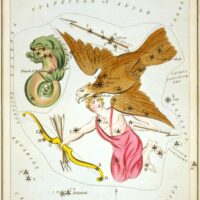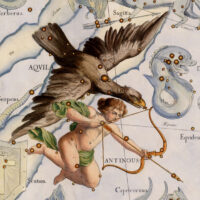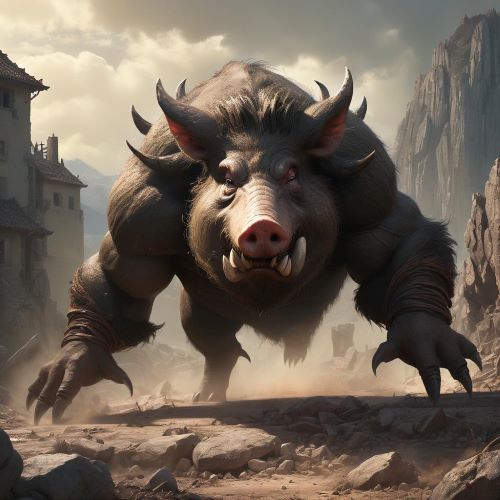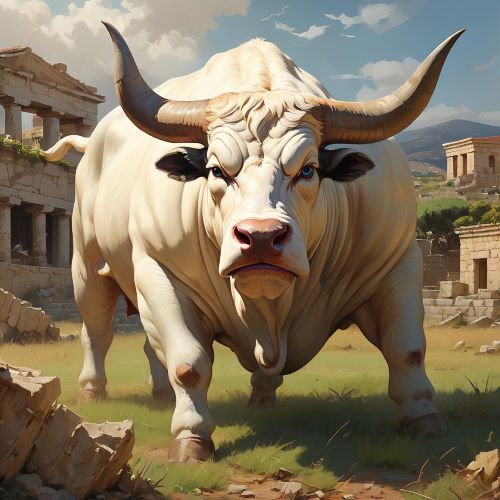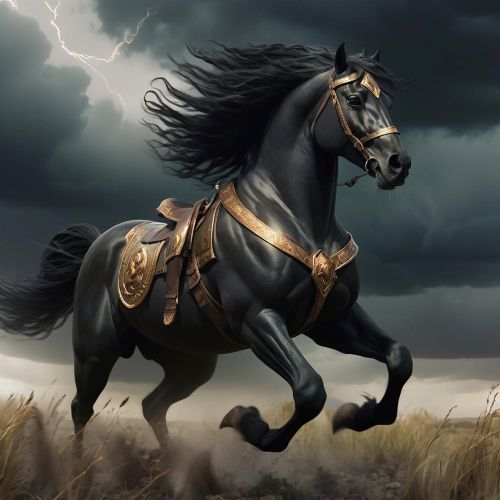Aquila : The Greek Majestic Bird
Listen
At a glance
| Description | |
|---|---|
| Origin | Greek Mythology |
| Classification | Animals |
| Family Members | N/A |
| Region | Greece |
| Associated With | Messaging, Constellation |
Aquila
Introduction
In Greek mythology, Aquila is best remembered as the eagle of Zeus, the mighty bird entrusted with some of the most sacred tasks of the king of the gods. Known in Greek as Aetos Dios, Aquila is woven into several powerful myths, most famously the abduction of the Trojan prince Ganymede, whom Zeus desired as his immortal cupbearer. The eagle either carried the youth itself or served as the divine disguise of Zeus during this act, depending on the version of the myth. In another account, the eagle appeared before the great Titanomachy as a victorious omen, convincing Zeus that triumph was within reach. To honor the bird’s role in divine affairs, Zeus placed Aquila in the night sky as a constellation, ensuring its legacy would shine eternally.
The Romans later inherited the imagery of Aquila, transforming it into one of their most potent military and political symbols, while astronomers immortalized it as one of the most recognizable constellations in the northern hemisphere. Aquila is thus both a mythological creature and a celestial landmark, bridging divine myth and human culture across centuries.
Physical Traits
Aquila is consistently portrayed as a grand and powerful eagle, the archetype of strength, dominance, and clarity of vision. Unlike many mythological beasts, Aquila is not depicted with hybrid features or exaggerated monstrous qualities. Instead, its majesty lies in its sheer natural form—a golden eagle of immense size, piercing eyes, and razor talons.
When represented in star maps, the constellation Aquila mirrors this image. Stretching across 652 square degrees of the sky, it is the 22nd largest constellation recognized by the International Astronomical Union. Its most luminous star, Altair, sits at the eagle’s heart, while nearby stars such as Alshain and Tarazed trace its wings and body. Ancient sky-watchers often envisioned the constellation as a soaring eagle in mid-flight, reinforcing its connection to Zeus’s divine messenger. The bird’s physical features, both in myth and in the heavens, underline its association with power, vision, and the swift execution of divine will.
Family
Unlike gods, heroes, and other anthropomorphic beings of Greek mythology, Aquila lacks a detailed lineage. It does not belong to the family trees of Titans or Olympians but instead emerges as a sacred creation or companion chosen by Zeus himself. In some mythic traditions, Aquila is described as having sprung from Gaia, the primordial goddess of Earth, reflecting its natural and cosmic essence.
Its closest mythological tie is with Zeus, functioning as both servant and symbol of the god’s authority. The eagle is also eternally linked with Ganymede, as the one who transported him from Troy to Olympus. In the celestial sphere, Aquila is considered part of the Hercules family of constellations, bordered by constellations such as Sagitta and Scutum, while sharing the sky with neighboring zodiac constellations Aquarius, Capricornus, and Sagittarius. This placement cements its role as part of a mythic constellation family rather than a genealogical one.
Other names
Throughout history, Aquila has been known by many names, reflecting cultural variations in its interpretation. In Greek tradition, it is most prominently called Aetos Dios, the “Eagle of Zeus.” This epithet highlights its service as the divine carrier of thunderbolts and harbinger of omens.
In Roman culture, the eagle became synonymous with Jupiter, Zeus’s counterpart, and was often referred to as Jupiter’s eagle. Roman star lore also identified the constellation as Vultur Volans, the “flying vulture,” though this was more a poetic variation than a separate myth.
In Babylonian astronomy, the stars of Aquila formed the constellation MUL.A.MUSHEN, also representing an eagle. This cross-cultural continuity demonstrates the widespread reverence for the eagle as a symbol of divine authority, celestial power, and unchallenged dominion over the skies.
Powers and Abilities
As the sacred eagle of Zeus, Aquila’s powers stem from its divine role rather than personal agency. Its abilities symbolize the functions entrusted to it by the king of the gods. Chief among these is its role as the bearer of thunderbolts, ensuring that Zeus’s most formidable weapon was always at hand. This ability represents both destructive potential and divine justice.
Aquila also serves as a celestial messenger, capable of traversing vast distances between the mortal and divine worlds. Its legendary strength and speed made it the ideal creature to abduct Ganymede and transport him to Olympus, a feat that became one of its defining mythological acts. In some accounts, the eagle had the power to summon rain, linking it to natural forces and the sustenance of life.
In Roman interpretation, the eagle became a symbol of omen and victory. During the Titanomachy, Zeus took the sight of an eagle as a sign of triumph, and thereafter, the bird was immortalized as a standard on Roman military banners, representing invincibility. In other myths, such as the transformation of King Periphas into an eagle, Aquila emerges as a guardian figure, entrusted with Zeus’s scepter and the privilege of standing near his throne.
Modern Day Influence
The story of Aquila did not end in antiquity. Its influence endures in astronomy, art, politics, and culture. The constellation Aquila remains a prominent celestial feature, especially visible during summer in the northern hemisphere. Its brightest star, Altair, is one of the three points of the famous Summer Triangle, a celestial landmark used for navigation and stargazing. Modern astronomers also study deep-sky objects within Aquila, such as the Glowing Eye Nebula, expanding the bird’s influence into scientific exploration.
Symbolically, the eagle inspired by Aquila continues to embody power, leadership, and authority. The Roman aquila became the military standard of legions, a tradition later echoed in modern national emblems. The United States’ Great Seal, for instance, depicts the bald eagle, directly drawing on the ancient symbolism of Zeus’s eagle as a sign of strength and protection. Sports teams, universities, and political institutions worldwide continue to adopt the eagle as a mascot, keeping Aquila’s symbolic legacy alive.
Culturally, Aquila’s story resonates in literature and the arts. The eagle’s divine associations have inspired poets, painters, and modern storytellers. From references in Greek tragedies to modern fantasy works, the image of a mighty eagle descending from the heavens often echoes Aquila’s mythic role. Organizations such as the Aquila Theatre keep Greek myths relevant by adapting them for contemporary audiences, while educational initiatives like Aquila Magazine introduce mythological themes to younger readers.
Even in science fiction and fantasy, the echoes of Aquila are apparent. J.R.R. Tolkien’s giant eagles, rescuers of heroes in The Lord of the Rings, are unmistakably inspired by mythological precedents like Aquila. Space operas and fantasy epics continue to use eagle imagery to represent divine intervention, cosmic journeys, and the triumph of good over evil.
Related Images
Source
Plotner, T. (2016, March 18). The Aquila Constellation. Universe Today. Retrieved from https://www.universetoday.com/articles/aquila
Wikipedia contributors. (2023). Aquila (constellation). Wikipedia. Retrieved from https://en.wikipedia.org/wiki/Aquila_(constellation)
Centre of Excellence. (n.d.). A Guide to the Aquila Constellation and Its Stars. Retrieved from https://www.centreofexcellence.com/the-aquila-constellation/
Frequently Asked Questions
What is lorem Ipsum?
I am text block. Click edit button to change this text. Lorem ipsum dolor sit amet, consectetur adipiscing elit. Ut elit tellus, luctus nec ullamcorper mattis, pulvinar dapibus leo.
What is lorem Ipsum?
I am text block. Click edit button to change this text. Lorem ipsum dolor sit amet, consectetur adipiscing elit. Ut elit tellus, luctus nec ullamcorper mattis, pulvinar dapibus leo.
What is lorem Ipsum?
I am text block. Click edit button to change this text. Lorem ipsum dolor sit amet, consectetur adipiscing elit. Ut elit tellus, luctus nec ullamcorper mattis, pulvinar dapibus leo.
What is lorem Ipsum?
I am text block. Click edit button to change this text. Lorem ipsum dolor sit amet, consectetur adipiscing elit. Ut elit tellus, luctus nec ullamcorper mattis, pulvinar dapibus leo.
What is lorem Ipsum?
I am text block. Click edit button to change this text. Lorem ipsum dolor sit amet, consectetur adipiscing elit. Ut elit tellus, luctus nec ullamcorper mattis, pulvinar dapibus leo.



